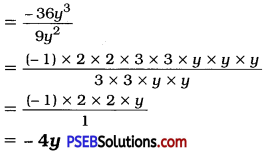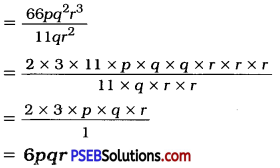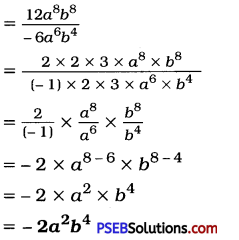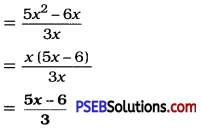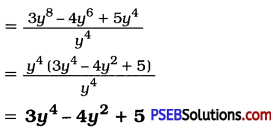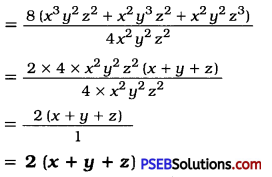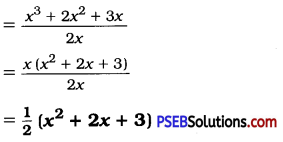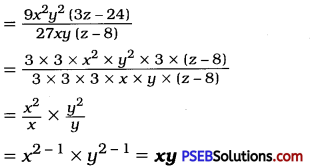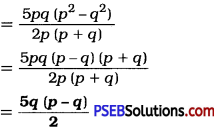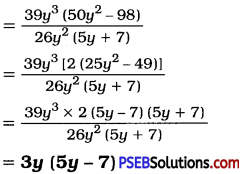Punjab State Board PSEB 8th Class Hindi Book Solutions Hindi Grammar Muhavare मुहावरे Exercise Questions and Answers, Notes.
PSEB 8th Class Hindi Grammar मुहावरे
मुहावरे :
जब कोई वाक्य या वाक्यांश अपने साधारण अर्थ को छोड़कर विलक्षण अर्थ प्रकट करे, उसे मुहावरा या वाग्धारा कहा जाता है।
वाक्य प्रयोग सहित मुहावरे
1. अपनी खिचड़ी अलग पकाना = सबसे अलग रहना,
प्रयोग – सबके साथ मिलकर रहना चाहिए, अपनी खिचड़ी अलग पकाने से कोई लाभ नहीं होता।
2. अन्धे की लकड़ी = एकमात्र सहारा,
प्रयोग – राकेश ही बुढ़ापे में मुझ अन्धे की लकड़ी है।
3. अन्धेरे घर का उजाला = इकलौता बेटा,
प्रयोग – रमन अन्धेरे घर का उजाला है, उसका ध्यान रखो।
4. अंग-अंग ढीला होना = थक जाना,
प्रयोग – दिन भर के परिश्रम से मजदूरों का अंग-अंग ढीला हो जाता है।
5. अन्तिम दीपक बुझना = आखिरी सहारा भी खत्म होना,
प्रयोग – पहले बड़े पुत्र की मौत हो गई और अब छोटे की, लाला राम नाथ का अन्तिम दीपक भी बुझ गया।
6. अँगूठा दिखाना = इन्कार कर देना,
प्रयोग – नेता लोग चुनाव के दिनों में बीसों वायदे करते हैं, परन्तु बाद में अँगूठा दिखा देते हैं।
![]()
7. अंगुली उठाना = दोष लगाना, निन्दा करना,
प्रयोग – कर्त्तव्यपरायण व्यक्ति पर कोई अंगुली नहीं उठा सकता।
8. अंगारे उगलना = क्रोध में जली-कटी बातें कहना,
प्रयोग – रावण को जब अंगद ने खरी-खरी सुनाई तो वह भरी सभा में अंगारे उगलने लगा।
9. अपना उल्लू सीधा करना = स्वार्थ निकालना,
प्रयोग-आज हर कोई अपना उल्लू सीधा करना चाहता है।
10. अगर-मगर करना = टाल मटोल करना,
प्रयोग-कभी भी अगर-मगर नहीं करना चाहिए सदैव हाँ या नहीं में उत्तर देना ही उचित है।
11. अपना खून देना = कुर्बानी करना,
प्रयोग – आजादी के लिए अनेक देशभक्तों ने अपना खून दिया था।
12. आँख उठाना-बुरी नज़र से देखना,
प्रयोग – पाकिस्तान की क्या हिम्मत जो भारत की ओर आँख उठा सके।
13. आँख मूंदना = मर जाना,
प्रयोग – लम्बी बीमारी के बाद बिन्दा ने सदा के लिए आँख मूंद ली।
14. आँखें बिछाना = प्रेम से स्वागत करना,
प्रयोग – प्रधानमन्त्री के आगमन पर नगरवासियों ने आँखें बिछा दीं।
15. आँखें मलना = जागना,
प्रयोग – पिता के उठाने पर मनोहर आँखें मलता हुआ बाहर आया तो दिन चढ़ चुका था।
16. आकाश से बातें करना = बहुत ऊँचे होना,
प्रयोग – राजधानी दिल्ली के कई भवन आकाश से बातें करते दिखाई देते हैं।
17. आड़े हाथों लेना = खरी-खरी सुनाना,
प्रयोग – सोहन के लगातार बोलने पर मैंने उसे आड़े हाथों लिया।
18. आग बबूला होना = बहुत कुद्ध होना,
प्रयोग – अंगद की खरी-खोटी सुनकर रावण आग-बबूला हो गया।
![]()
19. आँखों का तारा = बहुत प्यारा,
प्रयोग – सुनील तो अपनी माता-पिता की आँखों का तारा है।
20. आकाश-पाताल एक करना = बहुत प्रयत्न करना,
प्रयोग – चोर ने बचने के लिए आकाश-पाताल एक कर दिया लेकिन उसकी एक न चली।
21. आँखों में खून उतरना = बहुत गुस्सा आना-नौकर को अपने साथ जुबान लड़ाते देख सेठ जी की आँखों में खून उतर आया।
22. आग भड़क उठना = फैल जाना,
प्रयोग – छोटी-सी बात पर मुरादाबाद में साम्प्रदायिक दंगों की आग भड़क उठी।
23. आगे-पीछे घूमना = चापलूसी करना,
प्रयोग – आजकल बहुत से नेता मन्त्रियों के आगे-पीछे घूमते हैं।
24. आँखों में धूल झोंकना = धोखा देना,
प्रयोग – ठग राम की आँखों में धूल झोंक कर पाँच सौ रुपए ले गया।
25. आँखों में रात काटना = चिन्ता के कारण सो न सकना,
प्रयोग – कब तक आँखों में रात काटोगे ? यह मत भूलो कि हर रात के बाद सवेरा होता है।
26. आँखें भर आना = आँसू निकलना,
प्रयोग – भिखारी की दर्द भरी कहानी सुनकर मेरी आँखें भर आईं।
27. आँखें फेर लेना = बदल जाना, प्रतिकूल होना,
प्रयोग – अक्सर काम निकल जाने पर लोग आँखें फेर लेते हैं।
![]()
28. आँखों में चर्बी छा जाना = बहुत घमण्ड होना,
प्रयोग – लाटरी निकलने पर हर किसी की आँखों में चर्बी छा जाती है।
29. आँधी की भाँति बढ़ना = बड़ी तेजी से आगे जाना,
प्रयोग – स्यालकोट क्षेत्र में भारतीय सेना, आँधी की भाँति आगे बढ़ गई थी।
30. इधर-उधर की हाँकना = व्यर्थ की गप्पें मारना,
प्रयोग – राम सदैव इधर-उधर की हाँकता रहता है।
31. ईद का चाँद होना = बहत दिनों के बाद दिखाई देना,
प्रयोग – अरे सुरेश ! तुम तो ईद के चाँद हो गए हो, कहाँ रहते हो ?
32. उत्साह मन्द पड़ जाना = हौसला ठण्डा पड़ना,
प्रयोग – परीक्षा में एक बार असफल रहने पर दिनेश का उत्साह मन्द पड़ गया।
33. उल्टी गंगा बहाना = उल्टी बातें करना,
प्रयोग – आजकल माता-पिता बच्चों से डरने लगे हैं, अब उल्टी गंगा बह रही है।
34. उड़ती चिड़िया पहचानना-चालाक होना, दूर की बात जान लेना,
प्रयोग – मोहन ने धूप में बाल सफ़ेद नहीं किए, वह उड़ती चिड़िया पहचानता है।
35. उन्नीस-बीस का अन्तर = बहुत कम अन्तर,
प्रयोग – मोहन तथा सोहन के कद में उन्नीस-बीस का अन्तर है।
36. एक न चलना = कोई युक्ति सफल न होना,
प्रयोग – रावण की श्री रामचन्द्र के आगे युद्ध में एक न चली।
37. एक आँख से देखना = बराबर का बर्ताव,
प्रयोग – माता-पिता अपने सभी बच्चों को एक आँख से देखते हैं।
![]()
38. एड़ी चोटी का जोर लगाना = पूरा जोर लगाना।
प्रयोग – औरंगज़ेब ने शिवाजी को पकड़ने के लिए एडी चोटी का जोर लगा दिया, लेकिन सफल न हो सका।
39. कमर कसना = तैयार होना,
प्रयोग – आज देश की ग़रीबी दूर करने के लिए सबको कमर कसनी चाहिए।
40. काम आना = युद्ध में मारा जाना,
प्रयोग – कारगिल के युद्ध में अनेक भारतीय वीर काम आए।
41.कान में तेल डालना = किसी बात को न सुनना,
प्रयोग – अरे राकेश, क्या तूने कान में तेल डाल रखा है, जो इतना ऊँचा बोलने पर भी नहीं सुनता।
42. कोलाहल मचाना = बहुत शोर करना,
प्रयोग – स्कूल में छुट्टी होते ही बच्चे कोलाहल मचाने लगते हैं।
43. नकोरा जवाब देना = साफ़ इन्कार करना,
प्रयोग – जब मैंने सोहन से साइकिल माँगी तो उसने मुझे कोरा जवाब दे दिया।
44. कसौटी पर कसना = बहुत परखना,
प्रयोग – मैं पहले व्यक्ति को कसौटी पर कस लेने के पश्चात् ही मित्र बनाता
45. कुत्ते की मौत मरना = बुरी हालत में मरना,
प्रयोग – बुरे कार्यों में लिप्त रहने वाले सदैव कुत्ते की मौत मरते हैं।
46. कोल्हू का बैल – रात-दिन काम करने वाला,
प्रयोग – कोल्हू का बैल बनने पर भी आजकल निर्वाह कठिनता से होता है।
47. खून खौलना = बहुत क्रोधित होना,
प्रयोग – भरी सभा में द्रौपदी का अपमान होते देखकर भीम का खून खौलने लगा।
![]()
48. खून का प्यासा = कट्टर शत्रु,
प्रयोग – आज भाई-भाई के खून का प्यासा बन गया है।
49. खून का घूट पीना = क्रोध को दिल में दबाए रखना,
प्रयोग – हरगोपाल की पुत्रवधू उसकी गालियाँ सुनकर खून का चूंट पीये रहती है।
50. खून की नदियाँ बहाना = बहुत मार काट करना,
प्रयोग – सरहिन्द में बन्दा बहादुर ने खून की नदियाँ बहा दीं।
51. खून पसीना एक करना = बहुत परिश्रम करना,
प्रयोग – इस महँगाई के ज़माने में खून पसीना एक करना पड़ता है, तब कहीं जाकर निर्वाह होता है।
52. खाला जी का घर = आसान काम,
प्रयोग – दसवीं श्रेणी उत्तीर्ण करना खाला जी का घर नहीं है।
53. खरी-खरी सुनाना = सच्ची बात कहना,
प्रयोग – अंगद ने रावण को खरी-खरी सुनाई तो वह अंगारे उगलने लगा।
54. खेल बिगाड़ना = बने काम को खराब करना,
प्रयोग – अनिल तुमने बीच में पकड़कर हमारा सारा खेल बिगाड़ दिया। वह अभी मेरे साथ चलने वाला था।
55. खाक छानना = मारे-मारे फिरना,
प्रयोग – बचपन में राम पढ़ा नहीं, अब खाक छानता फिरता है।
56. गुदड़ी का लाल = बहुत प्यारा
प्रयोग-सचमुच सुनील गुदड़ी का लाल है। निर्धनता की अवस्था में भी
परीक्षा में जिले भर में प्रथम आया है।
57. गले लगाना = बहुत प्यार करना, आलिंगन करना,
प्रयोग – बुढ़िया ने देर से बिछुड़े पुत्र के मिलने पर उसे गले लगा लिया।
![]()
58. गले का हार = बहुत प्रिय,
प्रयोग – रीता इकलौती बेटी होने के कारण अपने माता-पिता के गले का हार है।
59. गागर में सागर भरना-संक्षेप में बहुत कुछ कह देना,
प्रयोग – रीतिकालीन कवि बिहारी जी ने अपने दोहों में गागर में सागर भर दिया है।
60. घर में गंगा = सहज प्राप्ति,
प्रयोग – अरे सुरेश ! तुम्हें पढ़ाई की क्या चिन्ता ? तुम्हारा भाई अध्यापक है, तुम्हारे घर में गंगा बहती है।
61. घुटने टेकना = आत्म-समर्पण करना,
प्रयोग – सन् 1971 के भारत-पाक युद्ध में पकिस्तान की सेना ने शीघ्र ही भारतीय सेना के आगे घुटने टेक दिए थे।
62. घाव पर नमक छिड़कना = दुःखी को और दुखाना,
प्रयोग – उसने मुझसे ऐसी बातें कह-कह कर मेरे दुःख को कम नहीं किया बल्कि मेरे घावों पर नमक छिड़क दिया है।
63. घी के दीये जलाना = खुशी मनाना,
प्रयोग – जब अयोध्या में श्री रामचन्द्र वापस पहुँचे तो लोगों ने घी के दीये
जलाए।
64. घाट-घाट का पानी पीना = अनुभवी होना,
प्रयोग – अनिल को कोई धोखा नहीं दे सकता क्योंकि उसने तो घाट-घाट का पानी पीया है।
65. चेहरे पर हवाइयाँ उड़ना = भयभीत होना,
प्रयोग-पुलिस को पहुँचा देखकर चोर के चेहरे पर हवाइयाँ उड़ गईं।
66. चकमा देना = धोखा देना,
प्रयोग – डाकू पुलिस को चकमा देकर चम्पत हो गए।
67. चलती गाड़ी में रोड़ा अटकाना = बनते काम में रुकावट डालना,
प्रयोग – आजकल चलती गाड़ी में रोड़ा अटकाने वाले बहुत हैं।
![]()
68. चल बसना = मर जाना,
प्रयोग – श्याम के पिता दो वर्ष की लम्बी बीमारी के बाद चल बसे।
69. चार चाँद लगना = मान बढ़ना,
प्रयोग – नवनीत ने आठवीं की परीक्षा में सर्वप्रथम आकर अपने कुल को चार चाँद लगा दिए।
70. चाँदी होना-बहुत लाभ होना,
प्रयोग – जब से तुमने व्यापार आरम्भ किया है, तुम्हारी तो चाँदी हो गई है।
71. चाल में आना = धोखे में फँसना,
प्रयोग – तुम्हें राम की चाल में नहीं आना चाहिए, वह ठग है।
72. चम्पत होना = खिसक जाना,
प्रयोग – सिपाही का जैसे ही ध्यान दूसरी तरफ हुआ कि चोर चम्पत हो गया।
73. चादर से बाहर पैर पसारना = आमदनी से बढ़ कर खर्चा करना,
प्रयोग – चादर से बाहर पैर पसारने वाले लोग अन्त में पछताते हैं।
74. चीत्कार कर उठना = ज़ोर से चीखना,
प्रयोग – कलिंग के युद्ध में भीषण मार-काट देखकर महाराजा अशोक चीत्कार कर उठा।
75. चुल्लू भर पानी में डूब मरना = बहुत लज्जित होना,
प्रयोग – अरे अनिल ! इस छोटे से पिट गए , चुल्लू भर पानी में डूब मरो।
76. छाती पर पत्थर रखना = चुपचाप दुःख सहना,
प्रयोग – शीला जिस दिन से अपने ससुराल आई थी, उसी दिन से उसने अपनी छाती पर पत्थर रख लिया था।
77. छक्के छूटना = हिम्मत हारना, घबरा जाना,
प्रयोग – महात्मा गाँधी के आन्दोलनों के समय अंग्रेजों के छक्के छूट गए।
![]()
78. छक्के छुड़ाना = बुरी तरह हराना,
प्रयोग – सन् 1971 के युद्ध में भारतीय सेना ने पाकिस्तान की सेना के छक्के छुड़ा दिए।
79. छठी का दूध याद आना = भारी संकट पड़ना, कठिनाई अनुभव होना,
प्रयोग – श्री रामचन्द्र ने तीक्ष्ण बाणों के प्रहार से रावण को छठी का दूध याद दिला दिया।
80. जंगल में मंगल होना = निर्जन स्थान में रौनक होना,
प्रयोग – जब से विद्यार्थियों की टोली ने इस स्थान पर अपना कैम्प लगाया है, तब से यहाँ जंगल में मंगल हो गया है।
81. जूतियाँ चाटना = खुशामद करना,
प्रयोग – मोहन दूसरों की जूतियाँ चाटकर अपना काम निकालने में निपुण है।
82. जूं तक न रेंगना = कुछ प्रभाव न होना,
प्रयोग – मैंने मोहन को कई बार चोरी करने से मना किया, लेकिन उस पर जूं तक न रेंगी।
83. जान हथेली पर रखना = मरने की बिल्कुल परवाह न करना,
प्रयोग – रणक्षेत्र में भारत के वीर सदा जान हथेली पर रख कर लड़ते हैं।
84. जलती आग में घी डालना = क्रोध को अथवा लड़ाई को बढ़ाना,
प्रयोग – अनि पहले से ही सोहन से नाराज़ था ऊपर से कमल ने सोहन के विरुद्ध भड़का कर जलती आग में घी डाल दिया।
85. ज़हर का पूंट पीना = क्रोध को दबाना,
प्रयोग – देवर की बातें सुन कर शीला को क्रोध तो बहुत आया लेकिन वह ज़हर का चूंट पीकर रह गई।
86. जादू का सा प्रभाव पड़ना-अच्छा प्रभाव पड़ना,
प्रयोग- महात्मा जी की बातों का श्रद्धालुओं पर जादू का सा प्रभाव पड़ा।
87. जान पर खेलना = खुशी से जान देना, प्राणों की परवाह न करना,
प्रयोग-भगत सिंह जैसे देशभक्त भारत की स्वतन्त्रता के लिए जान पर खेल गए।
![]()
88. जिगर का टुकड़ा = बहुत प्यारा,
प्रयोग – इकलौता बेटा अपने माँ-बाप के जिगर का टुकड़ा होता है।
89. जी चुराना = परिश्रम से भागना,
प्रयोग – अच्छे विद्यार्थी कभी भी पढ़ाई से जी नहीं चुराते।
90. टाँग अड़ाना = व्यर्थ दखल देना, रुकावट डालना,
प्रयोग – अरे प्रमोद ! अगर तुम सुरेश की सहायता नहीं कर सकते तो उसके काम में टाँग क्यों अड़ाते हो ?
91. टका-सा जवाब देना = साफ इन्कार कर देना,
प्रयोग – मैंने जब सुनील से 20 रुपए उधार माँगे तो उसने मुझे टका-सा जवाब दे दिया।
92. टेढ़ी खीर = कठिन कार्य,
प्रयोग – आजकल शिक्षित के लिए भी सरकारी नौकरी ढूँढ़ना टेढ़ी खीर है।
93. टक्कर लेना = मुकाबला करना,
प्रयोग – महाराणा प्रताप ने मुग़लों से टक्कर ली।
94. टस से मस न होना = ज़रा भी प्रभाव न होना, बात पर डटे रहना,
प्रयोग – बहुत समझाने पर भी जब वह टस से मस न हुआ तो मैंने उससे बोलना बन्द कर दिया।
95. ठोकरें खाना = धक्के खाना,
प्रयोग – प्रमोद पहले बचपन में पढ़ा नहीं और अब ठोकरें खाता फिरता है।
96. ठिकाने लगाना = मार देना, नाश कर देना,
प्रयोग-शिवाजी ने कितने ही मुग़लों को ठिकाने लगा दिया।
97. ठन-ठन गोपाल = जेब खाली होना,
प्रयोग – तुझे पैसे कहाँ से दूँ आज तो मैं भी ठन-ठन गोपाल हूँ।
![]()
98. डींग मारना = शेखी मारना,
प्रयोग – राकेश डींगें मारता है लेकिन वैसे पाई-पाई के लिए मरता है।
99. डंका बजना = प्रभाव होना, अधिकार होना, विजय पाना,
प्रयोग – आज विश्व भर में रूस की शक्ति का डंका बज रहा है।
100. डूबते को तिनके का सहारा = संकट में थोड़ी-सी सहायता मिलना,
प्रयोग – इस मुसीबत में तुम्हारे दस रुपए ही मेरे लिए डूबते को तिनके का सहारा सिद्ध होंगे।
101. ढाढस बंधाना = हौसला देना,
प्रयोग – शाम के पिता की मृत्यु पर सभी उसे ढाढस बंधाने लगे।
102. तलवे चाटना = चापलूसी करना,
प्रयोग – मुनीश दूसरों के तलवे चाट कर काम निकालने में बड़ा चुस्त है।
103. ताक में रहना = अवसर देखते रहना,
प्रयोग – डाकू सदैव डाका मारने की ताक में रहते हैं।
104. तिल का ताड़ बनाना = बात बढ़ाना,
प्रयोग – क्यों तिल का ताड़ बनाते हो ? इतनी छोटी-सी लड़ाई पर मुख्याध्यापक के पास जाकर शिकायत करना ठीक नहीं है।
105. तिल धरने की जगह न होना = बहुत अधिक भीड़ होना,
प्रयोग – वार्षिक परीक्षा के नतीजे के दिन पाठशाला में इतनी भीड़ थी कि तिल धरने की जगह न थी।
106. तिलाञ्जलि देना = त्याग देना, छोड़ना,
प्रयोग – तुम्हें मोहन जैसे स्वार्थी तथा शरारती मित्र को दूर से ही तिलाञ्जलि दे देनी चाहिए।
107. तूती बोलना = प्रभाव होना, बात का माना जाना,
प्रयोग – आजकल धनी व्यक्ति की प्रत्येक स्थान पर तूती बोलती है।
![]()
108. थाह लेना = पता लगाना, रहस्य पाना,
प्रयोग – किसी के दिल की थाह लेना बहुत कठिन काम है।
109. दम घुटने लगना = श्वास लेने में कठिनाई होना,
प्रयोग – आजकल यात्रा के समय इतनी भीड़ का सामना करना पड़ता है कि कई बार दम घुटने लगता है।
110. दंग रह जाना = हैरान रह जाना,
प्रयोग – अनिल के द्वारा चोरी किए जाने का समाचार सुनकर सभी दंग रह गए।
111. दिन में तारे नज़र आना = कोई अनहोनी घटना होने से घबरा जाना,
प्रयोग – जंगल में शेर को अपनी ओर लपकते देखकर प्रमोद को दिन में तारे नज़र आ गए।
112. दिन फिरना = अच्छे दिन आना,
प्रयोग – मित्रवर ! निर्धनता में इतना घबराओ नहीं, दिन फिरते देर नहीं लगती।
113. दाँत खट्टे करना = हराना,
प्रयोग – महाराणा प्रताप ने युद्ध में कई बार मुग़लों के दाँत खट्टे किए।
114. दिन दुगुनी रात चौगुनी = अत्यधिक,
प्रयोग – भूतपूर्व प्रधानमन्त्री श्री लाल बहादुर शास्त्री के नेतृत्व में भारत ने दिन दुगुनी रात चौगुनी उन्नति की।
115. दाल न गलना = वश न चलना,
प्रयोग – सुधीर ने अनिल तथा सुनील की मित्रता तो तोड़ने के लिए उनको लड़ाने का बहुत प्रयास किया लेकिन उसकी दाल न गली।
116. दांतों तले उंगली दबाना = आश्चर्य प्रकट करना,
प्रयोग – ताजमहल की सुन्दरता देखकर विदेशी दांतों तले उंगली दबा लेते
117. दौड़ धूप करना = खूब परिश्रम करना,
प्रयोग – बहुत दौड़-धूप की, तब कहीं छोटी-सी नौकरी मिल सकी।
![]()
118. दिल बाग-बाग होना = प्रसन्न होना,
प्रयोग – परीक्षा में प्रथम श्रेणी पाने पर मेरा दिल बाग-बाग हो गया।
119. धाक जमाना = रौब या प्रभाव पैदा करना,
प्रयोग – सिकन्दर की वीरता की धाक शीघ्र ही सारे संसार में जम गई।
120. धावा बोलना = हमला करना, .
प्रयोग – शिवाजी की सेना ने एकदम मुग़लों पर धावा बोल दिया।
121. धज्जियाँ उड़ाना = पूरी तरह खंडन करना,
प्रयोग – महात्मा गाँधी ने अंग्रेज़ों के अत्याचारों की धज्जियाँ उड़ा दीं।
122. धूप में बाल सफ़ेद न करना = अनुभवी होना,
प्रयोग – इस विषय में मेरी भी राय लेनी चाहिए थी; मैंने भी दुनिया देखी है, धूप में बाल सफ़ेद नहीं किये।
123. नाक में दम करना = बहुत तंग करना,
प्रयोग – वर्षा ने नाक में दम कर दिया है, कहीं जाना भी कठिन हो गया है।
124. नाक कट जाना = बदनामी होना, मान नष्ट होना,
प्रयोग – बेटे के कुकर्मों ने पिता की नाक कटवा दी। अथवा यदि तुम इस उत्सव में शामिल न हुए तो मेरी नाक कट जाएगी।
125. नाम कमाना = प्रसिद्ध होना,
प्रयोग – घर बैठे-बैठे नाम नहीं कमाया जा सकता।
126. नमक-मिर्च लगाना = छोटी बात को बढ़ा-चढ़ा कर कहना,
प्रयोग – हरीश के स्कूल से भागने पर सुरेश ने मुख्याध्यापक के सम्मुख खूब नमक मिर्च लगाकर उसकी शिकायत की।
127. नाकों चने चबाना = खूब तंग करना, भारी कष्ट पहुँचाना,
प्रयोग – सुभाष चन्द्र बोस जैसे वीरों ने अंग्रेज़ी सेना से टक्कर लेकर उनको नाकों चने चबा दिए थे।
![]()
128. नाक भौं सिकोड़ना = घृणा करना,
प्रयोग – युवतियों को आधुनिक ढंग के कपड़े पहने देख बुजुर्ग नाक भौं सिकोड़ते हैं।
129. नौ दो ग्यारह होना = भाग जाना,
प्रयोग – सिपाही को देखते ही चोर नौ दो ग्यारह हो गया।
130. नीचा दिखाना = हराना, घमंड तोड़ना,
प्रयोग – पाकिस्तान सदैव भारत को नीचा दिखाने की ताक में रहता है।
131. प्राण पखेरू उड़ना = मृत्यु होना,
प्रयोग – मोटर के नीचे आकर लड़के के प्राण पखेरू उड़ चुके थे।
132. पासा पलटना = उलटफेर होना,
प्रयोग – राम ने यह चाल सोच समझकर चली थी, परन्तु पासा पलट गया।
133. पैरों में पर लगना = बहुत तेज़ भागना,
प्रयोग – अपने चाचा के अमेरिका से आने का समाचार पाकर वह उनसे मिलने ऐसे दौड़ा जैसे उसके पैरों में पंख लग गए हों।
134. पैरों पर गिरना = क्षमा माँगना,
प्रयोग – सेठ का क्रोध बढ़ता देखकर नौकर उसके पैरों पर गिर पड़ा।
135. पानी में आग लगाना = क्रोध दिलवाना,
प्रयोग – अपने बॉस से राजेश की शिकायत करके मोहन ने तो पानी में आग लगाने का काम किया।
136. पेट में चूहे कूदना = बड़े ज़ोरों की भूख लगना,
प्रयोग – जल्दी से खाना दे दो भई, पेट में तो चूहे कूद रहे हैं।
![]()
137. पाँचों उंगलियाँ घी में होना = खूब फायदे में होना,
प्रयोग – भाई रमेश ! आजकल तो तुम्हारा व्यापार खूब चल रहा है, तुम्हारी तो पाँचों उंगलियाँ घी में हैं।
138. पानी-पानी होना = बहुत लज्जित होना,
प्रयोग – मेरे द्वारा सच्ची बात कहने पर राकेश पानी-पानी हो गया।
139. पानी फेरना = मेहनत बरबाद कर देना,
प्रयोग – बड़ी मेहनत से लेख लिखा था, मधु ने स्याही गिराकर उस पर पानी फेर दिया।
140. पीठ पर हाथ होना = पूरा सहायक होना,
प्रयोग – मोहन से झगड़ा मोल न लो, उसकी पीठ पर एक मन्त्री का हाथ
141. पीठ दिखाना = युद्ध से भाग जाना,
प्रयोग – युद्ध में पीठ दिखाना कायरों का काम है, वीरों का नहीं।
142. पट्टी पढ़ाना = बुरी सलाह देना,
प्रयोग – शीला ने अपने पति को ऐसी पट्टी पढ़ाई है कि वह अपने माता पिता की एक नहीं सुनता।
143. पलकें बिछाना = प्रेम से स्वागत करना,
प्रयोग – प्रधानमन्त्री के आगमन पर नगरवासियों ने पलकें बिछा दीं।
144. पसीना छूटना = घबरा जाना,
प्रयोग – कठिन प्रश्न-पत्र देखकर परीक्षार्थियों के पसीने छूट गए।
145. पगड़ी उछालना = अपमान करना,
प्रयोग – बड़ों की पगड़ी उछालना सज्जन पुरुषों को शोभा नहीं देता।
![]()
146. पाँव की जूती = गुलाम, तुच्छ वस्तु,
प्रयोग – नारी को पाँव की जूती समझना बड़ी मूर्खता है।
147. पत्थर की लकीर = अटल बात,
प्रयोग – श्री जयप्रकाश नारायण का कथन पत्थर की लकीर सिद्ध हुआ था।
148. पापड़ बेलना = कई तरह के काम करना,
प्रयोग-कमल कान्त ने कई पापड़ बेले हैं लेकिन टिक कर कहीं भी काम नहीं किया।
149. प्राणों के लाले पड़ना = जान जोखिम में होना,
प्रयोग – दुर्घटनाग्रस्त बस के सभी यात्रियों को अपने-अपने प्राणों के लाले पड़े थे।
150. प्राणों पर खेल जाना = बलिदान देना,
प्रयोग – देश को स्वतन्त्र कराने के लिए सैंकड़ों देश-भक्त प्राणों पर खेल गए।
151. फूला न समाना = बहुत प्रसन्न होना,
प्रयोग- श्री रामचन्द्र जी के अयोध्या लौटने पर उनका छोटा भाई भरत फूला न समाया।
152. बाट जोहना = प्रतीक्षा करना,
प्रयोग – अरे मोहन । तुमने बहुत देर कर दी, मैं कब से तुम्हारी बाट जोह रहा
153. बात का धनी = वचन का पक्का ,
प्रयोग – सतीश बात का धनी है। वह अवश्य आपकी सहायता करेगा।
154. बन्दर घुड़की = प्रभावहीन धमकी,
प्रयोग-भगत सिंह जैसे वीर अंग्रेजों की बन्दर घुड़कियों से डरने वाले नहीं थे।
155. बहती गंगा में हाथ धोना = सुधरी हालत में लाभ उठाना,
प्रयोग – जनता पार्टी के राज में अनेक लोग बहती गंगा में हाथ धोकर मालामाल हो गए।
![]()
156. बगुला भगत = कपटी,
प्रयोग – मोहन को अपनी कोई बात न बताना; वह धोखा देने वाला बगुला भगत है।
157. बांछे खिल जाना = बहुत खुश होना,
प्रयोग – अपने पास होने का समाचार सुनकर उसकी बांछे खिल गईं।
158. बाल की खाल निकालना = बहुत छानबीन करना, बहुत अधिक तर्क।
प्रयोग – विद्यार्थी को अपनी पढ़ाई में दत्तचित्त होना चाहिए। उसे बाल की खाल नहीं निकालनी चाहिए।
159. बाएँ हाथ का खेल = आसान काम,
प्रयोग – पी एच० डी० की उपाधि प्राप्त करना बाएँ हाथ का खेल नहीं है।
160. बाल बांका न करना = हानि न पहुँचाना,
प्रयोग – मेरे होते हुए कोई रमा का बाल बांका नहीं कर सकता।
161. बीड़ा उठाना-ज़िम्मेवारी लेना,
प्रयोग – श्री लाल बहादुर शास्त्री जी ने किसानों को ऊँचा उठाने का बीड़ा उठाया था।
162. बाल-बाल बच जाना = बड़ी कठिनाई से बचना,
प्रयोग – टक्कर तो बड़ी भयानक हुई थी पर रमेश बाल-बाल बच गया।
163 बैल के से दीदे निकालना = क्रोध से देखना,
प्रयोग – मालकिन ने नौकरानी से कहा, “अरी, बैल के से दीदे क्यों निकाल रही हो ? जाकर अपना काम करो।”
164. भंडा फोड़ना = भेद प्रकट करना, भेद खोलना,
प्रयोग – प्रवीण के वास्तविक बात न बतलाने पर राजेश ने उसका भंडा फोड़ दिया।
165. भूत सवार होना = धुन-सवार होना,
प्रयोग – उस कंजूस सेठ को तो धन कमाने का ही भूत सवार रहता है।
![]()
166. भाड़े के टट्ट = किराये का आदमी,
प्रयोग – आजकल सच्चा देशभक्त मिलना कठिन है। सभी भाड़े के टट्ट हैं।
167. मात खाना = हारना,
प्रयोग – कारगिल के युद्ध में पाकिस्तान को बुरी तरह मात खानी पड़ी।
168. मात देना = हरा देना,
प्रयोग – भारत ने अपने पड़ोसी देश को सभी क्षेत्रों में मात दी है।
169. मन में लड्डू फूटना = काल्पनिक आनन्द,
प्रयोग – भाई के विदेश से आने की खबर सुनकर सुधा के मन में लड्डू फूटने लगे।
170. माथा ठनकना = संदेह उत्पन्न होना,
प्रयोग – उसके घर पर ताला देख मेरा माथा ठनक गया।
171. मोती चुगना = अच्छी बात ग्रहण करना,
प्रयोग – सज्जनों की संगति से व्यक्ति मोती चुगना सीखता है।
172. मन मारना = इच्छा रोकना, मन को काबू में करना,
प्रयोग – सच्चा देशभक्त बनने के लिए मन मारना पड़ता है।
173. मिट्टी का माधो = निरा-मूर्ख,
प्रयोग – सभी विद्यार्थी रमेश को मिट्टी का माधो समझते थे लेकिन वह बहुत चालाक निकला।
174. मिट्टी खराब करना = बेइज्जत करना,
प्रयोग – अरे भाई साधारण-सी बात पर किसी की मिट्टी खराब करना अच्छा नहीं।
![]()
175. मुँह की खानी = बुरी तरह हारना,
प्रयोग – सन् 1971 के भारत-पाक युद्ध में पाकिस्तान को मुँह की खानी पड़ी थी।
176. मैदान मारना = जीतना,
प्रयोग – भारतीय फ़ौज ने देखते ही देखते छम्ब क्षेत्र में मैदान मार लिया।
177. रंग लाना = प्रभाव दिखलाना,
प्रयोग – विद्यार्थी की मेहनत एक-न-एक दिन रंग अवश्य लाती है।
178. रंग जमना = प्रभाव पड़ना,
प्रयोग – मुकेश के गीतों ने महफिल में रंग जमा दिया।
179. रंग उड़ना = डर जाना, हैरान होना,
प्रयोग – रीछ को देखते ही दोनों का रंग उड़ गया।
180. रंगा सियार = धोखेबाज़,
प्रयोग – तुम्हें सतीश की बातों में नहीं आना चाहिए, वह तो निरा रंगा सियार है।
181. रंग में भंग पड़ना = मजा किरकिरा होना,
प्रयोग – जलसा शुरू ही हुआ था कि रंग में भंग पड़ गया।
![]()
182. राई का पहाड़ बनाना = ज़रा-सी बात को बहुत बढ़ा-चढ़ा कर कहना,
प्रयोग – अपनी चालाकी से राई का पहाड़ बनाना तो कोई लीला से ही सीखे।
183. रोंगटे खड़े होना = रोमांच होना,
प्रयोग – सर्कस में शेर को दहाड़ता देख हमारे रोंगटे खड़े हो गए।
184. रफूचक्कर होना = भाग जाना,
प्रयोग – डाकू पुलिस को देखते ही रफूचक्कर हो गए।
185. लपेट में आना = वश में आना, घिर जाना,
प्रयोग – बेचारा निर्दोष राम चोरी की लपेट में आ गया।
186. लोहा लेना = मुकाबला करना,
प्रयोग – पाकिस्तानी सेना से लोहा लेने को हमारी सेना सदा तैयार रहती है।
187. लात पर लात रखना = बेकार बैठे रहना,
प्रयोग – इस कार्यालय में सब कर्मचारी लात पर लात रख कर बैठे रहते हैं।
188. लाल पीला होना = क्रुद्ध होना,
प्रयोग – अरे सुरेश ! क्यों लाल पीले हो रहे हो? कसूर तुम्हारा ही है।
189. लोहा लेना = युद्ध करना, मुकाबला करना,
प्रयोग – अधिकतर मुग़ल सम्राट राजपूतों से लोहा लेना नहीं चाहते थे।
![]()
190. लोहा मानना = शक्ति मानना,
प्रयोग – सम्पूर्ण एशिया भारत का लोहा मानता है।
191. लेने के देने पड़ जाना = लाभ के बदले हानि होना,
प्रयोग – भारत पर आक्रमण करके पाकिस्तान को लेने के देने पड़ गए।
192. लोहे के चने चबाना = अति कठिन काम, कष्ट अनुभव करना,
प्रयोग – भारत पर आक्रमण करके चीन को लोहे के चने चबाने पड़े।
193. लहू पसीना एक करना = बहुत परिश्रम करना,
प्रयोग – आजकल अच्छी तरह जीवन निर्वाह करने के लिए लहू पसीना एक करना पड़ता है।
194. सोने पर सुहागा = दोहरी अच्छाई या गुण,
प्रयोग – रमेश की पत्नी सुन्दर भी है और पढ़ी-लिखी भी उसके लिए सोने पर सुहागा वाली उक्ति ठीक बैठती है।
195. सिर पर भूत सवार होना = अत्यधिक क्रोध में आ जाना,
प्रयोग – अरे सुनील राम के तो सिर पर भूत सवार है, तुम्हारी वह एक न मानेगा।
196. सिंहासन डोल जाना = राज्य जाने का खटका होना,
प्रयोग – महात्मा गाँधी के आन्दोलन से अंग्रेज़ों का सिंहासन डोल गया।
197. हवा लगना = बुरा प्रभाव पड़ना,
प्रयोग – अब तो सुधा को भी शहर की हवा लग गई है, उसने बाल तराश लिए हैं।
198. हवा से बातें करना = तेज़ भागना,
प्रयोग – शीघ्र ही हमारी गाड़ी हवा से बातें करने लगी।
199. हक्का बक्का रह जाना = हैरान रह जाना,
प्रयोग – संजय गाँधी की मौत का समाचार सुनकर सभी लोग हक्के बक्के रह गए।
![]()
200. हँसी-खेल नहीं = आसान काम नहीं,
प्रयोग – इस नदी को तैर कर पार करना कोई हँसी-खेल नहीं।
201. हवा हो जाना = भाग जाना,
प्रयोग – पहरेदार को अपनी तरफ आते देखकर चोर हवा हो गया।
202. हृदय पर साँप लोटना = ईर्ष्या में जलना,
प्रयोग – हरीश की लाटरी निकलने का समाचार सुनकर सुरेश के हृदय पर साँप लोटने लगा।
203. हृदय टूट जाना = हताश हो जाना,
प्रयोग – पुत्र की मृत्यु पर वृद्ध का हृदय टूट गया।
204. हाथों के तोते उड़ जाना = बुरा समाचार सुनकर डर जाना,
प्रयोग – कारखाने में आग लगने की खबर सुनकर सेठ हरिदत्त के हाथों के तोते उड़ गए।
205. हाथ तंग होना = पैसे का अभाव होना,
प्रयोग – हमारा आजकल हाथ बहुत तंग है, कृपया नकद रुपया दें।
206. हाथ मलना = पछताना,
प्रयोग – अब फेल होने पर हाथ मलने से क्या लाभ, पहले डटकर परिश्रम करते।
207. हाथ धो बैठना = खो देना, छिन जाना,
प्रयोग – पाकिस्तान युद्ध में कई युद्धपोतों तथा पनडुब्बियों से हाथ धो बैठा।
208. हाथ पैर मारना = प्रयत्न करना,
प्रयोग – आजकल बहुत हाथ पैर मारने पर भी कठिनता से निर्वाह होता है।
![]()
209. हाथ पसारना = माँगना,
प्रयोग – स्वाभिमान शून्य व्यक्ति हर किसी के सामने हाथ पसारने लगता है।
210. हथियार डालना = हार मान लेना,
प्रयोग – बंगलादेश में पाकिस्तानी सेना ने साधारण युद्ध के बाद हथियार डाल दिए।
211. आँख लगना = नींद आना,
प्रयोग – वह ज्यों ही बिस्तर पर लेटा उसकी आँख लग गई।
212. आँखों से ओझल होना = गायब होना,
प्रयोग – देखते ही देखते चोर पुलिस की आँखों से ओझल हो गया।
213. ईंट से ईंट बजाना = नष्ट करना,
प्रयोग – युद्ध में भारत ने दुश्मन की ईंट से ईंट बजायी।
214. साँस फूलना = हाँफना,
प्रयोग – इतनी सीढ़ियाँ चढ़कर मेरी साँस फूलने लगी।






